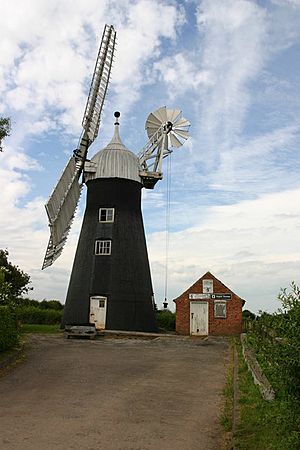Subscription Mill, North Leverton facts for kids
Quick facts for kids Subscription Mill, North Leverton |
|
|---|---|

Subscription Mill, July 2005
|
|
| Origin | |
| Mill name | Subscription Mill |
| Mill location | North Leverton, Nottinghamshire |
| Grid reference | SK 775 820 |
| Coordinates | 53°19′46″N 0°50′16″W / 53.32940°N 0.83770°W |
| Year built | 1813 |
| Information | |
| Purpose | Corn mill |
| Type | Tower mill |
| Storeys | Four |
| No. of sails | Four |
| Type of sails | Patent sails |
| Winding | Fantail |
| Fantail blades | Eight |
| Auxiliary power | Tractor |
| No. of pairs of millstones | Two, plus one pair not wind powered |
Subscription Mill is a working tower mill located in North Leverton, Nottinghamshire. It was built a long time ago, in 1813, and is still used today!
Contents
The Mill's Story
How the Mill Started
The Subscription Mill was built in 1813. Local farmers worked together to build it. They wanted a place to grind their grain into flour. The mill helped people in nearby villages like Fenton, Habblesthorpe, North Leverton, and Sturton le Steeple.
A group called the Subscription Mill Company was formed. This company made sure the mill ground corn for its members. It also helped other local farmers and even people who were poor.
Changes Over Time
In 1884, the mill got bigger. An extra floor was added to it. What makes this windmill special is that it has been working non-stop since it was built! This is very rare for old windmills.
A new company took over in 1956. The mill faced some challenges too. In 1959, lightning hit one of its sails and caused damage. Fixing it cost a lot of money, about £3,000. Different groups helped pay for the repairs. These included the Nottinghamshire County Council and the Council for the Preservation of Rural England. The repairs were done by special builders called millwrights from Alford.
Lightning struck the mill again in 1972. But don't worry, it was repaired the very next year!
How the Mill Works
Mill Design and Features
The Subscription Mill has four floors. It is built in a style common in Lincolnshire. It has four large sails called Patent sails. These sails are attached to a cross at the top. The top of the mill, called the cap, is shaped like an "Ogee" (a fancy curve).
At the back of the cap, there's an eight-bladed fantail. This small fan helps turn the cap so the main sails always face the wind.
Grinding the Grain
Inside the mill, there are three sets of millstones. Two of these sets are powered by the wind. This means the wind turns the big sails, which then turn the millstones to grind grain. The third set of millstones can be run by an outside engine or a tractor. This helps when there isn't enough wind.
Visiting the Mill
Open to the Public
The windmill is kept in great shape by a group of dedicated volunteers. They work hard to maintain it. You can visit the mill almost any time! It is open to the public every Saturday and Sunday throughout the year.
There is no charge to get in, so admission is free. However, there is a box where you can leave a donation. This money helps pay for the mill's upkeep and repairs.
Special Events
During the summer, the mill often has special "open weekends." These events have lots of fun things for visitors to see and do. It's a great chance to learn more about how windmills work and what life was like in the past.

